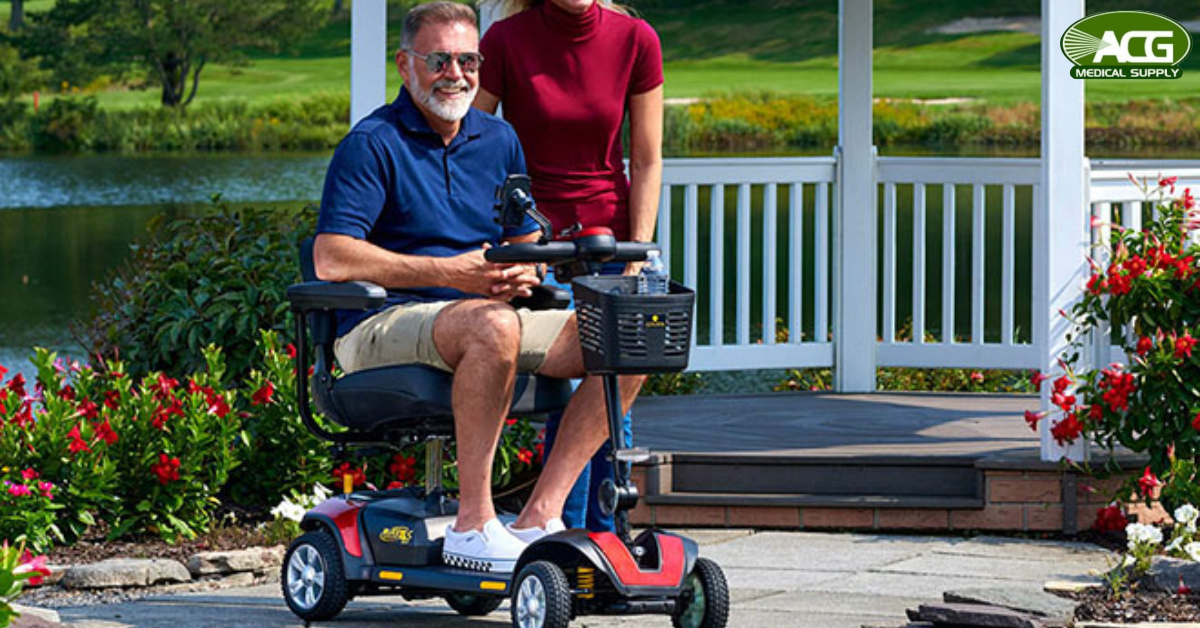The world shouldn’t shrink for someone just because walking is tough for them. Everyone deserves to move around on their own terms, and mobility scooters help with that. At ACG Medical Supply, we’re dedicated to providing real solutions, not just selling products. This guide cuts straight to the information you need, breaking down what actually matters when shopping for a scooter—no fluff, just facts—so you can find the perfect match and reclaim your independence.
Size
Here’s where most folks mess up. They assume bigger equals better, or that a compact model will magically fit anywhere. Neither’s quite right.
The Compact Travel Models
These are the lightweight ones that break apart into a few pieces. They’re designed to fit in your car trunk or come with you on the bus. If your days involve short trips to the grocery store, a doctor’s appointment, maybe wandering around the mall, these will work perfectly. They’re also great for people who don’t have much storage space at home.
But here’s the catch: Travel mobility scooters sure offer portability, but opting for portability often means sacrificing power and range. These scooters are meant to cover short ranges.
Mid-sized Options
This is where things get interesting. Mid-sized scooters offer more cushioning in the seat, batteries that last longer, and suspension that actually absorbs bumps. They’re heavier than travel models, sure, but they’re still quite manageable. Most people who use their scooters both inside as well as outside tend to choose the mid-sized power scooter for indoor and outdoor use. You get enough muscle for sidewalks and outdoor paths, but they’re not so bulky that you can’t navigate your kitchen or bedroom. Figuring out how to choose a mobility scooter often leads people right here.
The Heavy-duty Options
Now we’re talking about the big guns. These scooters are for those who need a higher weight capacity (500+ pounds) and want to cover long distances — think 20 to 30 miles on a single charge.
If you live somewhere with rough terrain, like cracked sidewalks or gravel paths, or you just want to spend an afternoon out without worrying about the battery, this might be your best bet. But they’re wide. Really wide. Small apartment with narrow hallways? This probably isn’t your match.
Style & Comfort Choices
Once the size is sorted, let’s talk about features and flair. You’re not just buying utility; you’re buying something you’ll be using daily. Brands like Pride Mobility electric scooters and Golden Technologies mobility scooters put serious thought into design, offering models that are both aesthetically pleasing and exceptionally comfortable.
Here’s where you get to personalize things:
Seating Comfort: Look closely at the seat. Some swivel, others recline. The padding and width should match your body perfectly—remember, you’ll be sitting here for extended periods.
The Little Details: Do you need simple, intuitive controls? How about a charging port for your phone? Don’t forget mobility scooter accessories! As these can make a world of difference to your day-to-day use.
Budget Reality
Here’s the thing about money and mobility scooters — you don’t need to empty your savings. There are plenty of affordable mobility scooters in the USA that work just fine without the premium price tag.
Here’s a break down:
| Category | Price Range | What You’re Getting |
| Travel/Compact | $800–$1,500 | Short trips, easy storage, lightweight |
| Mid-Range/Hybrid | $1,200–$2,500 | Daily use, indoor and outdoor capability |
| Heavy-Duty | $2,000–$4,000+ | Distance, durability, rough terrain |
Don’t buy features you won’t use. Mostly indoors? Skip the all-terrain models. But if getting outside equals independence, spending more now beats paying for repairs every three months.
ACG Medical Supply carries options across every budget… no pressure, just honest pricing.
Before You Buy — A Simple Checklist
Use this mobility scooter buying checklist to avoid headaches later:
- Measure your doors and typical routes (don’t guess)
- Know your weight plus what you typically carry
- Think about battery range, how far do you actually go?
- Consider transport needs (does it fold? Fit in your car?)
- Test the seat, comfort is more important than you think
- Check battery type (lithium-ion charges faster, lasts longer)
- Read the warranty fine print
- Ask about local service support
Test it if you can. Pictures lie. You won’t know if the seat’s comfortable or the controls are weird until you’ve actually driven it.
Conclusion
Nobody wakes up excited about buying medical equipment. But here’s what happens when you get the right mobility scooter: life opens back up a little. Maybe it’s finally getting to that bookstore across town. Or not having to skip family gatherings because the walking’s too much.
The whole point isn’t about finding the fanciest model with eighteen speed settings and cup holders that light up. It’s about getting back to doing normal stuff without paying for it later with pain and exhaustion. So, pick wisely.
FAQs
Q1. Can you actually fly with one of these?
Yeah. The folding ones with lithium batteries that pop out? Those usually work.
Q2. What happens if I get caught in the rain?
Light drizzle, you’re probably fine. But a real downpour? That’s pushing it. These things say “water-resistant” but that doesn’t mean waterproof.
Q3. Is it okay to just leave it on my porch?
Not really, no. Even with one of those heavy covers, moisture finds its way in. Cold nights, hot days…that stuff wears down the battery faster than you’d think. Garage is the best.
Q4. How much maintenance are we talking about here?
Get someone to look at it properly at least once a year.

